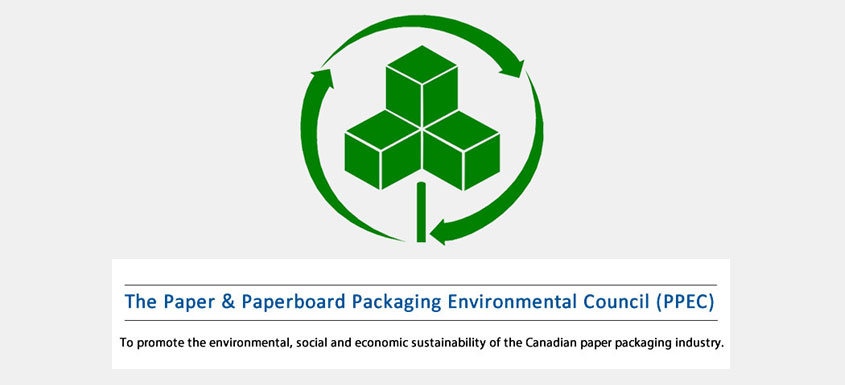With today’s International Day of Forests, the Paper and Paperboard Packaging Environmental Council (PPEC) would like to explain how sustainable forest management is critical to the circular economy of Canada’s paper packaging industry, and share the latest developments related to how forests can help mitigate climate change.
Environmental sustainability is at the core of PPEC member company operations and the Canadian paper packaging industry, including the sustainable management of Canada’s forests. And yet, misconceptions surrounding forestry and paper packaging persist when it comes to how paper packaging is made.
How Paper Packaging is Made
In Canada, paper packaging is made from virgin, recycled, or blended pulp (a mix of the two); with all paper fibre sources verified to be responsibly sourced by independent, third-party certification bodies.
Most domestic shipments of the three major paper packaging grades made in Canada – containerboard (used to make corrugated boxes), boxboard (used to make boxboard cartons), and kraft paper (used to make paper bags) – are made from recycled content (81.7%).
Mills also use sawmill residues – such as wood chips, shavings and sawdust left over from sawmill operations – and some supplement their pulp with virgin fibres from trees, which represents about 12% of the average paper-based box, carton, or bag.
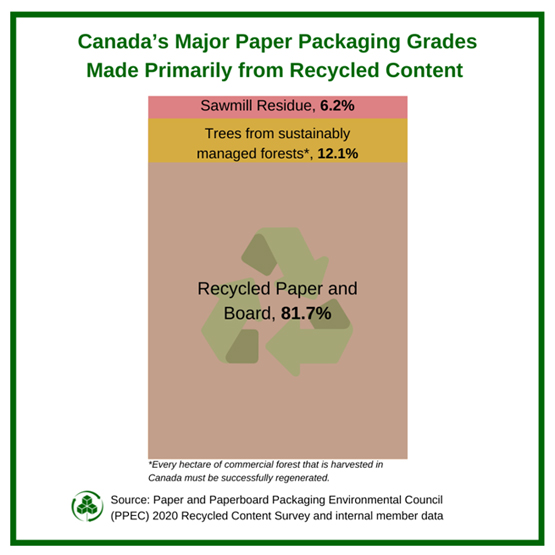
The mixture of using recycled content – old boxes and other paper materials collected from residential and business recycling programs – along with some new fibres from sustainably managed forests, is an important component to paper packaging’s circular economy.
First, by law, every hectare of commercial forest that is harvested in Canada must be successfully regenerated, so any trees that are harvested are replanted.
And second, through the important act of recycling, paper packaging is continually collected from Canadian residents and businesses, so it can be remade into new paper-based packaging products again and again.
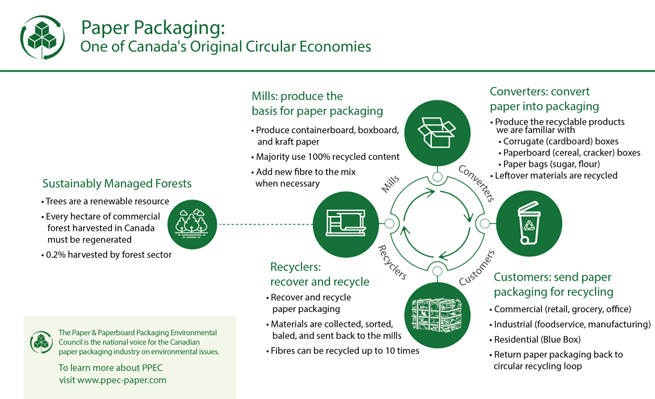
And while stats show that paper can be recycled up to seven times, and corrugated box fibres up to ten times, a recent study from Graz University of Technology in Austria found that fibre-based packaging material can be recycled at least 25 times without losing mechanical or structural integrity.
While this new research suggests that paper and board fibres are even more durable than previously thought, we know that over time fibres weaken, which means a small amount of new virgin fibre needs to be introduced now and again, which leads to a second common misconception regarding deforestation.
The Causes of Deforestation and the Role of Regeneration in Sustainable Forest Management
According to Natural Resources Canada’s State of Canada’s Forests 2020 Annual Report, Canada’s 347 million hectares of forest area is stable, with less than half of 1% deforested since 1990.
But there is often a lot of confusion about deforestation, which is when forest land is permanently cleared and converted to make way for new, non-forest land use.
Canada’s annual deforestation rate has been declining since 1990, when it was 64,000 hectares, down to about 34,300 hectares in 2018. During that time, less than half of one per cent of Canada’s total forest area was converted to other land uses.
The major causes of deforestation are due to agriculture, mining, oil and gas projects, new homes, and the development of ski hills and golf courses, which together represent over 90% of deforestation in Canada.
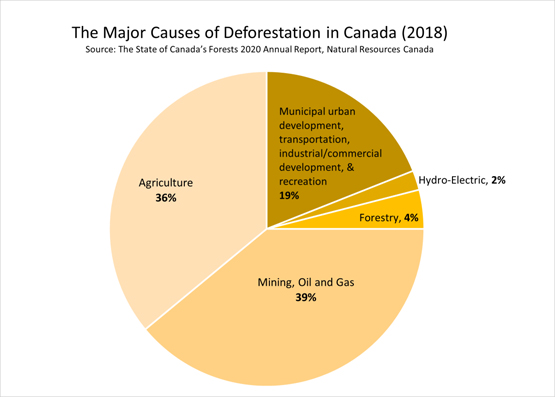
The forestry sector’s (which includes pulp and paper manufacturing and the wood product manufacturing subsectors) share of deforestation represents 1,494 hectares, or approximately 0.0004% of total deforestation in Canada.
And given that the Canadian paper packaging industry doesn’t use much in the way of freshly cut trees, the little that is harvested (0.2% in 2018) must be successfully regenerated (427 million seedlings were planted across Canada in 2018), making packaging’s share of deforestation zero.
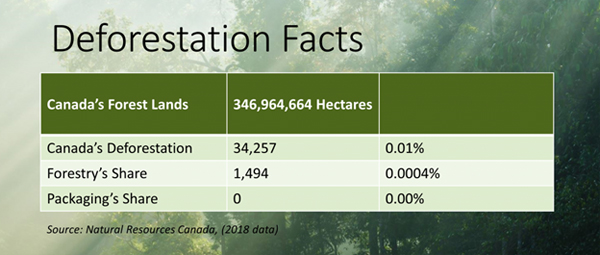
The Role of Forests in Mitigating Climate Change
Sustainable management of y managed forests have an important role to play in helping to mitigate climate change, as trees capture and store carbon, acting as carbon sources or carbon sinks: a forest is considered a carbon source if it releases more carbon than it absorbs, and a carbon sink if it absorbs more carbon from the atmosphere than it releases.
The Canadian government knows this and has committed to plant two billion additional trees by 2030, which would represent a 40% annual increase in the number of trees already being planted, and would lower emissions by up to 12 megatonnes annually by 2050 by removing carbon from the atmosphere.
Considering the carbon storage by forests is just one of the many recommendations from a new report by the United Nations’ Food and Agriculture Organization (FAO), Forest Products in the Global Bioeconomy: Enabling substitution by wood-based products and contributing to the Sustainable Development Goals; which speaks to the role renewable forest products have in helping to combat climate change, and explores how wood-based products could help replace fossil-based and GHG-intensive products:
“There is strong evidence at product level that wood products are associated with lower GHG emissions over their entire life cycle when compared to products made from non-renewable or emissions-intensive materials. A review of 488 substitution factors obtained from 64 published studies indicates that the use of wood and wood-based products is generally associated with lower fossil and process-based emissions when compared to non-wood, functionally equivalent products. However, over three-quarters of studies in the literature focus on the construction sector and significantly less information exists for other traditional forest products such as paper for printing, writing, and packaging, or emerging forest products.”
As Two Sides North America’s Kathi Rowzie explained in Can Paper Help Save the Planet?:
“The document left open for later study the extent to which paper and paper-based packaging may serve as substitutes for non-wood products in the search for those that contribute to the net reduction of greenhouse gases, but there’s little doubt that any product sourced from materials that are grown and regrown are better for combating climate change than the non-paper alternatives.”
In addition to the FAO’s new report, the Forest Products Association of Canada recently released the documentary, Capturing Carbon, highlighting the role of sustainable forest management and wood products in helping to mitigate climate change; and the World Business Council for Sustainable Development released its Forest Sector Net-Zero Roadmap, about the forest sector’s role in enabling the transition to a net-zero economy. These are just a few of the developments related to forestry’s role in addressing climate change, which PPEC is monitoring.
When we use and recycle paper-based packaging, we all play a part in protecting and replenishing our renewable resources, contributing to the sustainable management of Canada’s forests, and supporting the circular economy of the paper-based packaging industry.
On International Day of Forests, it is important to remember that Canada’s forests are stable and sustainably managed.
 Rachel Kagan
Rachel Kagan
Executive Director
The Paper & Paperboard Packaging Environmental Council (PPEC)



